| |
A Little Help Please
From: John Lewis email: hjohnlewis@compuserve.com
Hi Ken,
You got me started in this electric R/C hobby with your suggested LT-25, which as I
have told you in the past, I built EXACTLY to your recommendations and have learned to fly with, proudly, never so far, having
flown a glow powered plane!
I went solo in June of this year, and since then have been flying a new LT-25 with
a MaxCim N32-13Y, Maxu35c-21 controller, 3.00:1gearbox, 13x8 prop and 14 3000mAh NiMH cells. I don't quite have the
performance of "your" LT-25, but for training it gives me almost 20 minute flights.
I also have an Amptique with an Astro 802G 7 2000 NiMH cells, a Sig Rascal
with an Astro 020 direct drive, and finally, a SR Batteries Cutie. Again, I built it as SR suggested with their power system and
also as you suggested using the Magnetic Mayhem. This worked well until the motor pulled out of the model! (Oops. KM) Fortunately the plane was moderately in balance and it continued in a gentle glide to the ground with absolutely no damage. So far, I have been unable to find the motor!!
Ken, I would like to move on to a plane with more performance. I have read the
e-conversion for the Ace Cloud Dancer and also the reports on your own Web site for the Sig Four Star 40. But both seem to me
to use rather old power systems, considering the new Hacker motors etc. I wondered if you could recommend a "Dream"
combination of power system and airframe which is not too small.
I would appreciate any thoughts that you may have.
With all best regards,
John
(John then followed up with this email. KM)
Dear Ken,
I sent you an e-mail on the 15th that was not important. But since then, I have had
the chance to think about it's content.
Basically it was asking for some advice with what to build after "YOUR"
LT-25.
Please, may I suggest that rather than answering me directly, you "put on
your thinking cap", to come up with a follow on plane from the LT-25 and publish it on your web site, as a companion
article to, "Getting started with electrically powered radio controlled model airplanes".
I know that you have a large following and if I as one of them, could make use of
this information, then there must be many others.
Finally, hopefully not to bore you. Last weekend I entered my first fun fly at
another one of our Kansas city clubs. I used my LT-25 and happily drew utter amazement that such a large electric plane could
perform equally alongside everything else. I even came third in the water bombing event !
By the way it is up graded to 20 by 3000 mAh NiMH high voltage Panasonic cells.
With a MaxCim motor. It goes like a rocket and flies for a very long time.
Thanks Ken for getting me into this. It is FUN!
With all best regards,
John
(Okay, John. This one’s for you! KM)
Return to "What's In This Issue?"
Movin’ On Up
By Ken Myers
John Lewis suggested that it would be a good idea to follow up "Getting Started
with Electrically Powered Radio Controlled Model Airplanes" with a "What Do I Do Next" article. Thanks,
John.
Step Up 1: Change the Power System and Functions of the "trainer"
When your trainer has served you well, and you feel that it is time to move on, here
are my recommendations.
The first thing to do is to change the power system and flight control functions of the
"trainer". John used the Sig LT-25 as his trainer and had it set up as I had recommended; Astro Flight cobalt 15
motor with optional 2.82:1 gear ratio, basic 4-channel radio, Master AirScrew 12x8 wood prop, 2 seven cell battery packs, Astro
Flight 217D speed control, and Astro Flight Zero Loss Connectors.
Since this is already a 4-function “trainer”, no functions need to be added. If the
trainer was a 3-function type, I would recommend adding the 4th function, whether it be ailerons or rudder. If the
"trainer" was a 3-function type without ailerons, ailerons can just be hinged onto the trailing edge and a servo or
servos added for aileron control. If there was no rudder, add one.
If the “trainer” has a flat bottom airfoil, it would be a good idea to change it to a
semi-symmetrical airfoil by building a new wing for it. This isn’t necessary, but generally, just tacking ailerons onto a flat-bottom
airfoil produces some strange control changes. Ask anyone who’s ever flown a Sig Kadet, the 40 size, with ailerons!
Change the power system to what I like to call the bottom of the performance
range.
Using John’s LT-25 "trainer" as an example, the power system that
would fly it like a performance plane would have the following characteristics.
Performance Type Plane: LT-25
Wing Area: 724
Target Wing Loading: 24.7 oz./sq.ft.
Target Flying Weight: 124 oz.
Target Power System Weight: 62 oz.
Target Finished Airframe Weight: 43.5 oz.
Target Airborne Radio Weight: 18.6 oz.
Target Battery Weight: 41.4 oz.
Target Motor weight: 20.7 oz.
Prop Diameter: 13 in.
Prop Pitch: 10 in.
Target MPH: 65 mph
Target RPM: 6,540
Target Required Power Out: 420.5 watts
Number of cells: 20
I will not go into the math again, suffice to say, I have a spreadsheet that I use, and
will be happy to use for you and give you a reply.
John’s emails to me indicated that he had changed the power system to a MaxCim
brushless geared 3:1 using 14 cells and turning a 13x8 prop. He then went to 20 cells, but didn’t state if he changed the gear ratio
or prop size. He had pretty much "maximized" this airframe.
Step Up 2: Modify the "Trainer" Power System and Change the Airframe
Modify the original "trainer" power system and place it in a performance
plane, low-wing sport or sport scale airframe of the appropriate size.
In John’s case, he could use his AF15G on 14 cells in a new, modified way. If a
geared motor was used on the trainer, as a general rule, to run the same number of cells and have a performance system, the
gear ratio must be lowered or possibly be eliminated, as well as a decrease in the prop diameter and increase in the prop pitch.
John was running the 11-tooth pinion to give a gear ratio of 2.82:1. By replacing the 11-tooth pinion with the original 13-tooth
pinion, the gear ratio returns to the original 2.38:1 ratio.
The specs for a low-wing beginning performance airframe, using the AF15G
w/2.38:1 ratio and 14 cells would be something like this:
Beginning Performance Type Low-wing Plane:
Wing Area: 470 - 500 sq.in.
Target Wing Loading: 21.8 oz./sq.ft.
Target Flying Weight: 75.8 oz.
Target Power System Weight: 37.9 oz.
Target Finished Airframe Weight: 26.5 oz.
Target Airborne Radio Weight: 11.4 oz.
Target Battery Weight: 25.3 oz.
Target Motor weight: 12.6 oz.
Prop Diameter: 10 in.
Target Prop Pitch: 8 in.
Target MPH: 62.7 mph
Target RPM: 7,850
Target Required Power Out: 203 watts
Number of cells: 14
Step 3: Extract the Performance Power System from the "Trainer" and Provide It with a New
Airframe
The performance system can now be extracted from the modified "trainer"
airframe and inserted into a new low-wing performance plane.
John’s MaxCim brushless w/3:1 gear ratio would work well in a plane with the
following specifications.
Performance Type Low-wing Plane:
Wing Area: 590 - 670 sq.in.
Target Wing Loading: 24 oz./sq.ft.
Target Flying Weight: 112 oz.
Target Power System Weight: 56 oz.
Target Finished Airframe Weight: 39 oz.
Target Airborne Radio Weight: 16.8 oz.
Target Battery Weight: 37.3 oz.
Target Motor weight: 18.7 oz.
Prop Diameter: 12
Prop Pitch: 9
Target MPH: 64 mph
Target RPM: 7,200 rpm
Number of cells: 20
In Summary
These are the steps that I would recommend in moving up in power and performance
from a "trainer" aircraft.
- Take the existing airframe to a performance level with power and functions.
- Modify the "original trainer" power system into a performance system and place it in a new, appropriate size
performance type airframe.
- Use the performance system from the original "trainer" in a new, appropriate size performance airframe.
By the time you complete these "steps" you should be well into electric
and ready for just about anything!
I have not recommended a specific plane or system, since it really depends on
where you start.
If you read this closely, you’ll notice that Mr. Larry Sribnick is already using this
very idea with his Cutie and X-250 kits. Train on the Cutie, pull the power system and move on up with the X-250. Great job
Larry.
As always, what you do next is up to you, but if you follow my guidelines, you’ll
have a lot of fun, gain a lot of skill and experience and utilize your equipment to the fullest.
Return to "What's In This Issue?"
48" Kaydet
From: Ron Daniels email: ADani60140@aol.com
members.aol.com/rwdrc
Dear Ken,
I read the posting in the November E-zone about the 48" Sig Kaydet. I don't
know which one it is (the Mk II was a bit heavier than the "stick" ones), but the weight estimate seems a bit high to
me. Keep in mind, radio equipment is much lighter than when some of these old designs came out. My HOB Chipmunk says 28
ounces for flying weight on 2 channels with an 049 glow. Mine is 26 1/2 on 4 channels with 4 channels, and 9 500AR's on
board.
The teal airplane that I flew at Mid-Am this year is, for all intents, a heavily
modified Sig Kaydet. It is a 1/2 size version of my 100" BP 100 (MAN, May 2001). The BP 100 was based on my RCM
Stubby (63" span). The Stubby was built around a Kaydet Seniorita wing with dihedral cut in half and some ailerons
added.
Here is the BP 50 E. It is powered by a Trinity Speedworks 350 ( double wind, 17
turn, comparable to Kyosho "Atomic Force") motor, with a M/A 2.5:1 gearbox, and 7X1700 SCR cells, through a
Great Planes Electrifly 50 A ESC. I use an APC 10 X 8 prop.
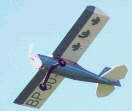
With this very tame power system, the airplane (~3 lbs, total) will get off of grass in
10-15', pavement in under 6', using 1" chord flapperons set to about 20º. The flapperons stop a bit inboard of the tip to
effectively create wash-out when they are deflected. Take off distances are about 50% longer without flaps, and the flaps allow
flying from rough fields during my lunch hour, that would require too large wheels without flaps.
Climb out is solid, though not outstanding, and fully aerobatic flights last about 7
minutes. It does not have the power for square loops, and sinks moderately during knife-edge, but can do nearly any thing that I
want to.
I've flown it with 10 1000 SCR's, and the performance is obscene, but my ESC
kicks out after about 1 1/2 minutes to keep the BEC from quitting due to the heat. I think 8 sub-C cells would be perfect, and
plane to try that next.
Below is an RCM Stubby built by Peter Riddle, as an electric.
Peter electrified this one using a 12 V drill motor. Ready to fly, this 12 cell Sig
seniorita based airplane weighs 3 7/8 lbs. He deleted the struts to limit drag, and I copied this when I made the 50" one. I
also narrowed the fuselage, for the same reason.

These planes are a bit shorter in length than an equal sized Kaydet, but have 3 1/3
layers of fuselage longerons, rather than the 2 the Kaydet has, as well as the extra weight of counterbalanced tail surfaces. The
basic wing structure is virtually identical to a Kaydet, but with ailerons added.
My point is that the airframe weight should be about the same. These Stubby/BP
airplanes make excellent electric conversions. The Kaydets should do even better, as they have a sleeker, more efficient
fuselage. However, for electric, you may want to pick your own wood, and scratch build, as every gram saved is another gram
of battery you can cram on board..........
A local fellow has made a 42" Kaydet for electric. I'm recommending geared
S-480, and 8-10 CP 1300's. I'm looking forward to seeing it fly!
Return to "What's In This Issue?"
San Diego Mid-Winter Electrics
Presented by:
The Silent Electric Flyers of San Diego, Hitec and Model Airplane News
Come to the West coast’s largest Electric Airplane event in warm, sunny San Diego, California and enjoy up to 4 days of
electric airplane flying on our new hard surface runway at beautiful Mission Bay. San Diego is a great family vacation destination, just
minutes form the world famous San Diego Zoo, Balboa Park, Sea World and other parks and attractions. This year’s new format will
include fewer events an MORE OPEN FLYING.
When: President’s Day Weekend, Friday thru Monday (Open Flying Monday) Feb. 15, 16, 17, 18, 2002
Where: The NEW, easy to find Silent Electric Flyers “hard surface” flying field directly east of the Sea World
parking lot. See Web site for details. www.sefsd.org
Information: Bill Everitt: Phone: 760.753.1055
Fax: 760.633.2271
Email: billeveritt@cs.com
Or Glen Merritt at 858.748.6948 ext. 310
How Much $ Friday - Sunday $15 a day or $25 for all three days. Monday is FREE!
Indoor Flying check the Web site or call for updated times and locations for this event.
|
Return to "What's In This Issue?"
Super PTE
From: Nick Mati nicdor@indra.com

Hi Ken,
We've talked before. I have finally found some other electric flyers in Colorado!
Attached is a picture of a Great Planes PT Electric that I have upgraded with a
Magnetic Mayhem Reverse, MA 3:1 Gearbox, 12x10 MA prop. Performance is pretty good on 7 cells and awesome on 8 cells
(750+ fpm climb rate).
I have a two page plan in .PDF format that I can send you if you would be
interested in posting it on your website. I also have a 16 page manual on how to build the "Super PTE" out of a standard PTE.
As part of the upgrade, I have added a steerable nose wheel. The plan PDF's aren't bad, but the manual pdf is about
10 megabytes.(I could probably compress it more). I also have about a half dozen "Super PTE" kits that include the Mayhem,
Gearbox, 12x10, wheels, new landing gear, Sermos connectors, etc., etc. for $120 each + S&H that I'd like to find good homes
for. No radio, batteries, speed controller, charger, covering or glue.
I was going to try to do a business around the upgrade, but it is not looking very
encouraging at this point. I had this misconception that there was a market out there for a turn key package; that you could just
build the airplane the way the instructions said, used the parts they gave you and it flew great! I've had a lot of people ask me
about this plane, and they seem to get
turned off when I start explaining you have to change this or this other part from this other vendor. Apparently people would
rather be nickel and dimed to death. So much for my misguided efforts to help get new people in the hobby.
Didn't want to sound like an ad. Either way, you are welcome to post the plans
and manual. I have a website at www.milehighflight.com
Last point. It is pretty easy to upgrade an existing PTE with these changes. I was
going to do a separate manual for that but....
The plane in the picture started out life as a stock PTE.
I am still trying to compress the instruction manual down to something
reasonable, but I have posted the plans on my website at
www.milehighflight.com/conversions.htm
Feel free to download a copy and post on your website at your convenience.
Regards,
Nick
Return to "What's In This Issue?"
November 2001 EFO Meeting

Norm Dmuchowski showed his new Hacker B20 w/4:1 gear box, 7 cell 300 mAh, 5
amps with 10x7 prop.
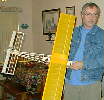
Richard Utkan shared his partially completed, 1/2A Texaco that he won at Ft. Wayne. It has 280 sq.in. of wing area.
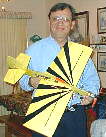
Rick Sawicki had an Edge 540 3D from Radical R/C. It is a beta version and
weighs 10.9 oz with a Dymond 301 motor which puts out 11.5 oz. of thrust, so that 3D aerobatics are possible. It uses an 8 cell
triple A 800 mAh NiMH pack and is a 4-channel ship.
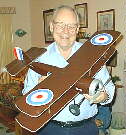
The Sopwith Pup is Jack Lemon‘s and produced by, Kavan. It is all foam. Jack
had to pre-wire everything and then stuff it in. It weighs 18.4 ounces.
Gus Nuerenberg won the Mid-America Electric Flies 2001 video from SKS Video.
Thank you Scott.
Return to "What's In This Issue?"
The December Meeting

Ken,
The meeting started at Ken’s house with refreshments and lots of e-talk. Of course
the SKS video of the Mid-Am was playing as "background" on the TV, since several of the members had not yet
seen it. It is available from SKS Video Productions 1.800.988.6488
While we are a bit biased, we believe it is one of the best electric flight videos
every produced. Besides that, we get a big bang out of watching ourselves, and of course picking on one another.
About eight-thirty, we packed up and headed for the Oakland Yard golf dome for
some indoor flying.
When we arrived, our good friend from Cincinnati, Don Belfort was already there.
He’d brought up a couple of his friends with him. Lots of folks were flying. The kids were having a great time during the free
flight portion of flying. Dave runs a tight ship and keeps the schedule moving. The Cutie flew with its stock power system just
fine in the dome. Jack flew his Sopwith, while others had a good time with their planes. Great!
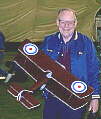
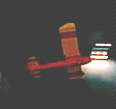
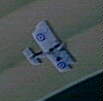
Return to "What's In This Issue?"
P-51
From: Mark Rittinger mrittinger70@hotmail.com

Hey Ken,
Just a note to let you know the Reno Racer version of my Mid-Am D model P-51 is
done and flying. The ship has same 42" span, pink foam wing, and 3.5:1 geared Magnetic Mayhem running 10-1250 mAh
NiCads or 2000 mAh NiMH cells with a 12-10 APC prop. Weight is still under 45 oz.
First flight was faultless, only needed minor trim. Flight times are good, and
vertical is great, especially early in the run. Flies every bit as good as the Detroit Miss.
Article is done and headed for Model Airplane News for publication.
Plans are available now from me for $22.00 for those interested.
Next up is the P40, same size and power, and a speed 400 B25...
Later,
Mark Rittinger
 Return to "What's In This Issue?"
Return to "What's In This Issue?"
Electrifying a CAP 232 ?
From: Al Fisher ALBERT1957@aol.com
Hi Ken,
I'm thinking of electrifying a Hangar 9 CAP 232 1.20 ARF airplane. Could you
please help me determine what size Astro Flight motor, what size prop, and how many batteries are needed to accomplish this
feat.
Here are the following specifications:
Wingspan:.........73"
Wing Area:......1031 sq. in.
Weight (Approx):......11-12 lb.
Length:......67 1/4"
I would appreciate any information you may have on this.
Thanks,
Al Fisher
Hi Al - Here is what I’d recommend:
Performance Type Plane: CAP 232
Input Wing Area: 1031 sq.in.
Target Wing Loading: 27.8 oz./sq.ft.
Target Flying Weight: 198.9 oz. or 12.4 lb.
Target Power System Weight: 99.5 oz.
Target Finished Airframe Weight: 69.6 oz.
Target Airborne Radio Weight: 29.8 oz. (not excess weight can be added to airframe weight. Approx. 18 more oz. bringing airframe to about 88 oz.)
Target Battery Weight: 66.3 oz.
Target Motor weight: 33 oz.
Prop Diameter: 16 in.
Prop Pitch: 12 in.
Target MPH: 68 mph
Target RPM: 5,680
Target Required Power Out: 758.6 watts
Input Motor Name to try: AF 90 11T
Estimated number of cells: 30 or 31
It should be noted that I put Al in touch with Dave Grife who’s flying a similar size
Hangar 9 Edge 540. I believe Dave is using 40 cells, and I’m not sure which motor.
Return to "What's In This Issue?"
The XB-70 and a Cool November Morning
From: Grant Calkins CasinoOp@worldnet.att.net
(See the December 2001 Ampeer for XB-70 photo)
After numerous trips to the Edwards AFB flying site to urge Ray Cannon's
magnificent XB-70 bomber to take to the air - all without any significant success - The Calkins/Cannon Consortium made what
Ray termed "one last try before I strap a kerosene burning turbine engine to this beast". The date was Wed Nov 21, 2001, and
the weather was somewhat threatening for midday aeronautics on the high desert of California. But we had left our home in
Camarillo at 5:30 am and were to meet our "Maiden flight pilot" Tony Frawkowiak at the field at first light.
As Ray prepped the 13.25 lb. XB-70, Grant Calkins handed the Tx to his U-2 to
Tony. Grant knows difficult flying conditions with an equally flaky U-2 when he sees them. If Tony can't fly it nobody can.
With a takeoff roll practically to Bakersfield (cold morning equals insufficient charge of flight battery, or so says Grant), the U-2
lifted off slowly and began a steep climb. Winds blew the big-winged spy plane hither and yon, but she arrived where she started
about 5 minutes later, and in one piece. One down, two to go.
Next ready was Ray's venerable B-47 with four EDFs that has won so many
plaques and awards that Ray has lost count. Just four days before, Best Electric and Best Boeing Plane at the Arizona Jet Rally
in Tucson, Arizona with Tony again at the controls. This aircraft practically leaps into the air off the lakebed surface, and before
it's 5 minute flight was finished Tony had it doing multiple rolls and some serious bombing runs. Two down.
Next the XB-70. Tony sensed that Ray was serious about the IC turbine if the
plane stayed a sled once more. Twenty six 1700 mAh NiCads charged (each of the four EDFs see 13 cells), Ray placed the
giant on the runway. Before he could turn and walk away, Tony had the XB-70 rolling into the wind. Then, earlier than anyone
expected, the nose lifted, the bomber continued to roll a while on mains only, then lifted it's entire body into the air at about a 30
degree angle of attack. It was up! It continued to climb slowly, looking as beautiful as the original North American Aviation
prototype of the 70's, until we heard Tony say "out of roll trim...gotta bring her down". He completed the long oval lap with a
picture perfect landing on the mains, then gently lowering the nose to a three wheeled stop. Wow!
Well the XB-70 may have performed just in time to avoid an IC turbine transplant.
Ray says the turbine is coming anyway, but the giant bomber with the cobra-like nose was sure a beautiful sight humming over
the flat desert floor.
Following long standing tradition all pilots adjourned to the right-out-of-the-old-west
Skillet in Rosamond for the equally traditional maiden flight Jackass Kicker Omelet, with Ray picking up the tab. It was very
tasty and a long time coming!
Grant Calkins and Ray Cannon
Channel Islands Condors and Muroc Model Masters (Edwards AFB), California
Return to "What's In This Issue?"
Request for Plans and Info: Falke 25 SC & Beaufort
From: Edward Irving edirv@iprimus.com.au
Hi Ken,
A message from Oz-- actually a request, in light of your online offer of assistance
to modellers "with a problem".
I came across your website (Ampeer) while looking for information on the Falke
25 SC Motorglider. At least 2 sources of kits seems to be available, but what I am looking for is a plan and/or any detailed
information of the full sized aircraft which would enable a model to be constructed as near scale as possible.
I have had the same problem with my desire to make a model of the twin engined
Bristol Beaufort bomber (not the Bristol Beaufighter ) and any lead here would be appreciated. These proposed models are to
be electric of course.
I do have small 3-views of both of these models but that is about all!
Any information or leads to further details would be appreciated.
My current models are electric sailplanes - one of which you may
know: Electrafly- and the others are local designs as well as an old-timer "Flamingo" with an Astro 25 and a Lazy
Bee built from the plan (modified to suit my ideas of improvements ) which has a geared Astro 05. The sailplanes have geared
Astro 05 (12*6 folder ) or Graupner 600 direct drive (9*5 folder ) and all on 7* 1700 or 2000 Nicad or NimH batteries. Bench
current about 25 amps in each case. Sailplanes weigh about 3.25 lb.
I'm going to apply your calculations as on the website and see how they
fit . All the models perform quite adequately.
Yours in anticipation -- Ted Irving
( Heathcote Soaring League ) H.S.L.
( Eurobodalla Model Aero Club ) E.M.A.C.
Return to "What's In This Issue?"
Nifty Field Box
From: Walter Thyng docwt@lightfirst.com

Hi Ken:
Sears has Keter Rolling ToolCart (#65482) on sale for $24.95 . It's a great field box. I
picked one up about a month ago.
First of all, the top has two fixed parts trays, then the front of the top half has a
removable parts tray. What you can't tell in the photo is that it is a two piece unit. It divides at the yellow line around the
middle.
I've got all my regular field box stuff in the top half (multiple trannys, chargers,
props, little bits etc.) and keep my field battery in the bottom. If I'm flying where I can park close I can leave the battery home.
If I go to a field where the parking is further away from the flightline I can take the battery along, snap the two halves together
and have a nifty rolling cart that makes it easy to move the heavy stuff. I'm sure there are other ways to set it up.
Walt
Return to "What's In This Issue?"
Ellipstik 400
From: Ray Williams rwilliams@babe.net.au
Hi Ken,
I have just flown the above and what an aircraft! It is the greatest!
I purchased the plans from the Australian agent who recommended the econo
motor and a 7x6 Gunther prop[as per the plans] all this together with the purchase of 2 sheets of medium 1/8 balsa and
lightweight clear covering came to a grand total of $A46.50 [$23.00 US approx.]. That's a cheap outfit by anyone's gauge! Building time was about one day. I found the building straight forward but did have some difficulty with the covering and keeping it neat. The bare airframe was painted orange on the top and remained natural on the base.
Modifications were done to the engine mount in that the engine was held on with
rubber bands to eliminate the possibility of the prop catching and tearing the engine and mount out of the airframe. The C of G
was moved forward and more reflex added. These changes were made as a result of reading an article in an old Ampeer. With light weight equipment, 7 X 600AE power pack, the fully charged weight was 13 oz. [377 gms]. The plan recommends 14 to 16 oz.
I must admit I had concerns about the power train as my meters indicated peak
revs of 6200 and a current draw of 7.25 amps. My normal power trains peak at 13,000 and draw approx. 6 amps. This low noise
but, ample power system is different to anything I have so far flown. Like most modellers I equate power with noise.
The first flight, was as all first flights, nerve racking. It left my hand and headed
toward the ground. A simple touch of the up stick and it gained height easily [ more reflex needed]. The low noise power train is
very deceptive and the aircraft gained height and became small very quickly. As a first flight it was a non event the machine
behaved perfectly and the landing was really just a plop on to the grass. I need not have worried about the engine mount.
I have since cranked up the throws and it will happily loop in its own length, fly
inverted with hardly any down, roll crisply and float around at low power for ever.
Flight times average 7 minutes
My challenge at this time it to find the smallest area I can fly the Ellipstick in.
For a low cost, fly anywhere, highly manoeuvrable easy to build aircraft it has no
peer. Build one you will not be disappointed.
Happy landings,
Ray Williams
Return to "What's In This Issue?"
Computer Radios
From: Scott Black sblack@progression.net
Hi Ken,
It was nice to see the pictures of the St. Julie fun fly in a recent Ampeer. It brings
back memories of my best flying day this season.
It also reminds me of an interesting incident. I have always said that there is a
foolproof way to guard against computer radios, multiple Txs' and all - that is to do a complete control check before EVERY
flight. I always do, even if I only have one airplane at the field and it is the 4th flight and nothing changed since last flight. I also
ALWAYS check that the controls move the RIGHT way - not just a wiggle check. But you know, Murphy is a cunning SOB and
that day he bit again.
I was flying Paul's F-15, and it was the second flight. It has tailerons so it uses the
same mixes that a flying wing would use. Paul also had a Razor there that day. You can see where this is headed.....
So there is the jet, sitting on the bungee ramp. I wiggle the controls. Up - yep -
that's up. Left - yep - that's left etc. I could see the direction, but I couldn't tell that there was not nearly enough deflection. So
we blasted off and I was holding full up to stay level!!! Then I had to turn and managed to find the electric trim (which
I don't have on mine) and dial in full trim yelling "What the $@#^%@^!!!". With full trim and about half-up I could hold level.
With full everything I could do shallow turns. The flight was brief and the landing was easy. Absolutely totally full up and leaning
back and bending the stick! I looked down at the Tx and there it was written on the LCD big as life - RAZOR. I don't have an
text display on mine so I never thought to look when he handed me the Tx. He was busy fiddling with the plane and forgot to
check. The careful preflight checks that I always do failed simply because I assumed he had the right setting (won't do that again)
we were unlucky enough to be flying another elevon mixed airplane on the same Tx! What are the odds....
No damage, just 2 red faces.
Computer radios are here to stay and we have to deal with them. I personally think
they are great. A thorough control check is always mandatory for any model or full sized airplane and this should prevent most
(but not all) mistakes.
Return to "What's In This Issue?"
To Reach Ken Myers, you can land mail to the address at the top of the page. My E-mail
address is:
KMyersEFO@aol.com
EFO WEBsite: http://members.aol.com/KMyersEFO/
|
|















